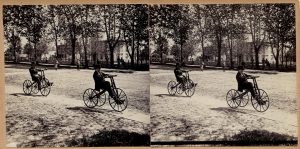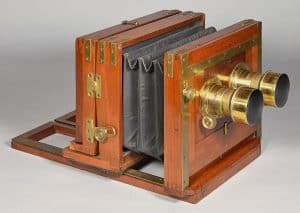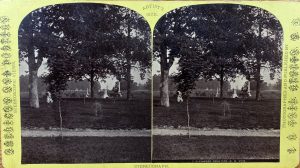Stereo Cards in Our Collection
By John Marks, Curator of Collections
Several months ago a first-year William Smith student came to the archives to do research. She was very enthusiastic and, out of the blue, asked, “Do you have stereo cards of Geneva?” She owns a stereoscope although she didn’t bring it to school with her. I pulled out a viewer and reproduction cards from our educational collection. She was thrilled to see three-dimensional photos of Geneva in the late 1800s.
So much for, “Young people don’t care about history.”
In 1832 English physicist Sir Charles Wheatstone created a mirror stereoscope to explain how binocular vision works. Two different images are sent to the brain which creates one three-dimensional image. In 1849 Sir David Brewster used lenses instead of mirrors to view images. He presented his device at London’s Great Exhibition in 1851 and it became hugely popular.
In 1859 Oliver Wendell Holmes, Sr., father of the Supreme Court Justice of the same name, invented the hand-held stereoscope. It was light, easy to make, and adjustable to each viewer. Rather than patent the invention, Holmes published his design for anyone to copy. Although many designs followed, Holmes’ is the most common when one looks for vintage stereoscopes.
Stereo cards, or stereographs or stereograms, were made with a binocular camera. It took two images at once, about 2.5 inches apart. While the camera (image on the right) used glass plate negatives, stereo cameras developed along with photography. They can be found on the internet for many time periods.
Stereographs were popular from the late 1860s into the 1900s. Photographer James G. Vail worked in Geneva from around 1862 to 1880. Many of his images were made and sold as stereo cards. Although much of his work has been printed as regular photos, the glass plate negatives show they were taken with a stereo camera.
Most of Vail’s cards were stamped with his name and had identification along the bottom of the right hand image. The most interesting ones have a foreground, middle, and background to show off the three-dimensional effect.
While we have digitized our stereo cards, they still need to be seen through a stereoscope to be appreciated. Director of Education Anne Dealy has used them with school groups for many years. Aside from the inevitable, “Let me see, it’s my turn!” the stereoscope never fails to amaze kids used to higher technology.




I am glad you have the cards and the viewer at the GHS,
It is quite fascinating.My maternal grandmother in Sweden had one and I was always excited to look at her pictures when I visited.
Thanks, John